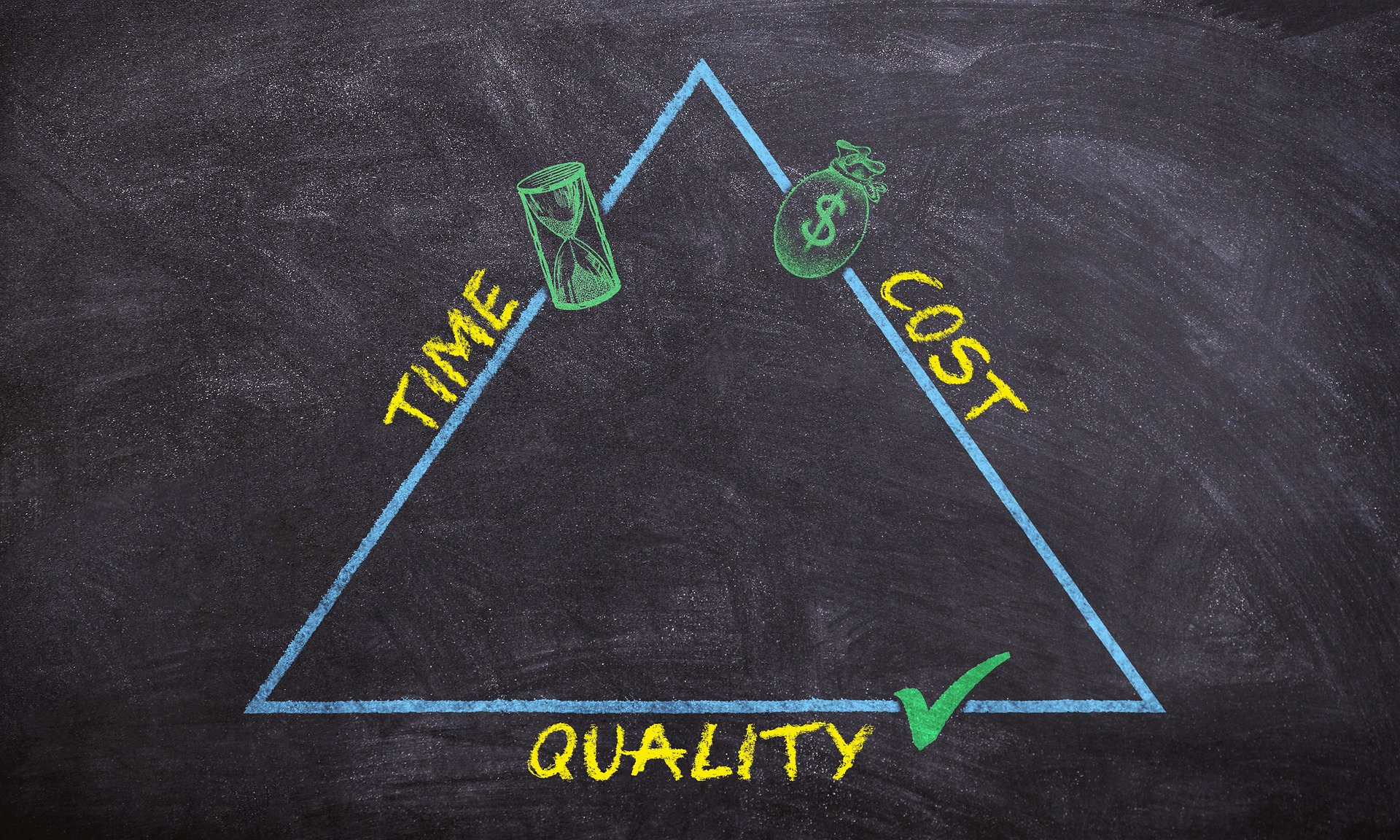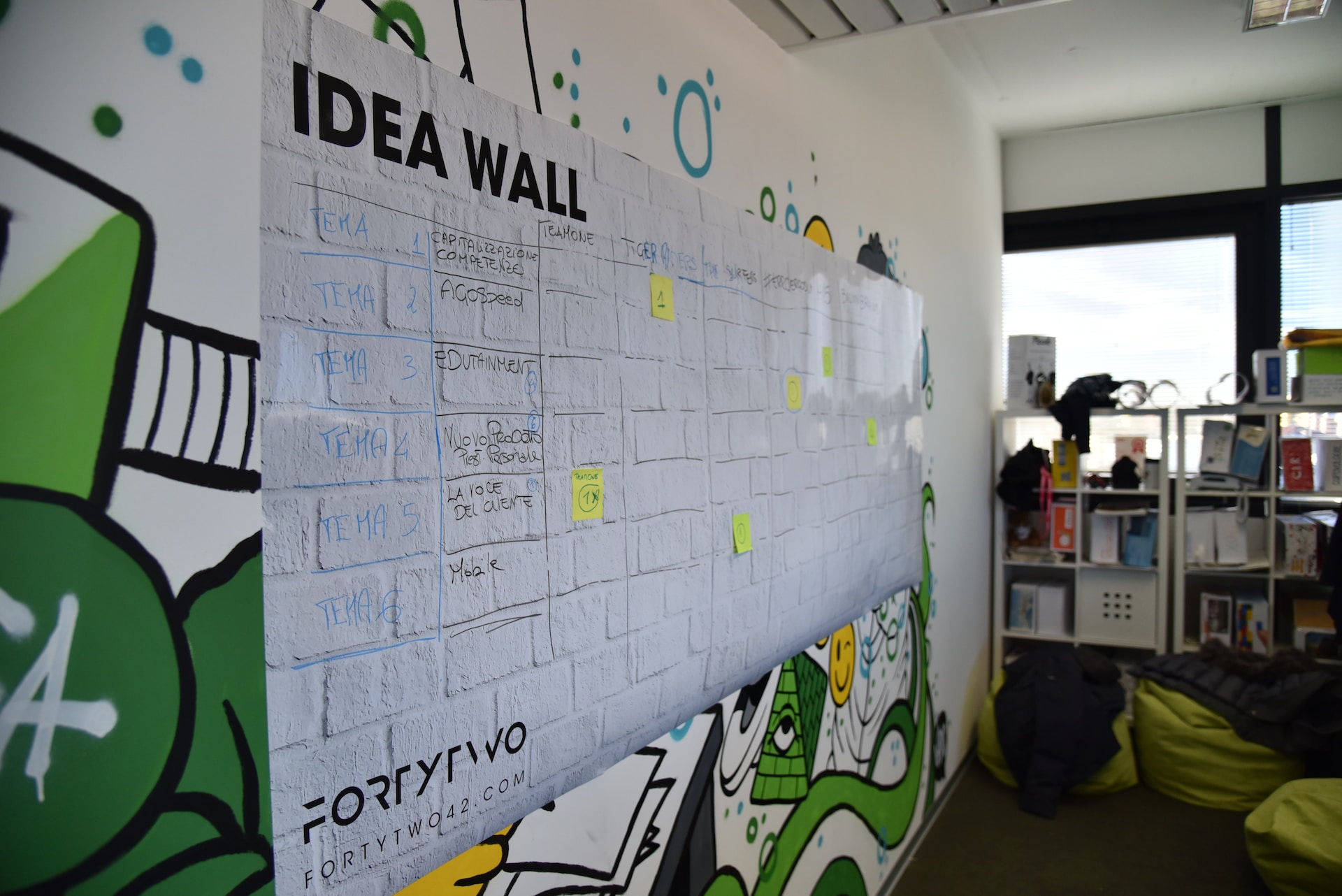All the terms related to project management that you should know are detailed below. I’ve made sure to include essential concepts that will help you understand your future professional endeavors. Once understood, it will be easy to put these terms into practice.
Project Management Glossary of Terms
Before entering the world of project management, one must understand the following terms and concepts.
Letter A
Acquisition Process
The process through which both resources and employees are found and gathered. These two elements must be put together for the project to run smoothly. This process relies on the project’s timeline and budget.
Action Item Status
An action item is a task that the team must complete. Its status tells us the action’s progress and can range from the creation to the finish. Most workloads contain more than one action item. So, keeping their statuses updated is essential for a successful outcome.
Activity Label

An activity’s brief description. These labels come underneath each arrow in the “activity on arrow” diagram. Activities are grouped into categories and listed in columns. They each have numeric identifiers.
AOA
“Activity on arrow” is a network diagram that uses arrows as visual signs to showcase different activities. Inside the chart, some nodes represent the project’s milestones or events. These diagrams feature finish-to-start relationships.
AON
“Activity on node” is another diagram showing nodes as activities. At the same time, arrows are symbols of logical relationships that occur between activities. Unlike AOA, AON can feature different relationship varieties:
- Start to start;
- Finish to finish;
- Finish to start;
- Start to finish.
*Activity – the smallest work unit that requires time, money, and other resources to be completed.
APF
Adaptive project framework is a modern project management approach that contradicts linear and traditional methodologies. Instead, APF allows external economic elements to impact the project. Moreover, it accepts and encourages flexibility and change.
Agile
There’s an entire family of Agile frameworks, including Kanban, Scrum, Lean, and more. All these are iterative development methodologies. Through them, the team does its best to achieve all the client’s requirements that might regularly change. They focus on small stages named sprints. Each sprint consists of incremental improvements.
Agile projects are adaptive, and customer involvement is high. The team relies on user stories to improve the final product.
Aggregate Planning

It’s a project management strategy that relies on demand forecasts. With this tool’s help, you can schedule or plan your project’s tasks and events from three to eighteen months in advance. That way, managers can assign tasks to new employees and acquire other resources efficiently.
Administrative Closure
This concept comprises multiple formal requirements that, once achieved, can support a project’s completion. The closure requires team members to document deliverables and their formal acceptance. Moreover, through administrative closure, stakeholders or sponsors receive complete and relevant information regarding the project.
Analytical Estimating
It’s a method through which teams determine how much a project will cost and how much time it will take to complete. It’s done for each activity, and then employees combine these estimates to create the project’s overall estimation. Many project management experts perceive this technique as a highly accurate one.
Letter B

Baseline
This concept refers to the manager’s approved parameters like timelines and expenses. These are settled before the project begins. Then, throughout the project’s development, the baseline acts as a reference point. That way, the team can establish if they operate within those parameters. Otherwise, certain project areas might need adjustments.
Backward Pass
This metric calculates finish dates and late starting points for project management initiatives. It works from finish to start, beginning from the project’s completion date. Moreover, it does that for each project’s activity.
Burst Point
This point appears on diagrams and shows where numerous project activities originate. Through this metric, we can see that several different activities have the same source as their predecessor. There’s a catch, though: each action can only start as soon as the team completes its predecessor.
Burn Down Chart
This is a project management chart featuring the connection that forms between two elements:
- The number of chores a team has to finish;
- Their timeline – how long they have left until the activity’s due date.
BPM
Business process modeling is a method through which PM specialists evaluate a company’s processes. They will then be able to improve that business through representation, analysis, and evaluation. First, you create visual models. Then, you must align operations before improving operational efficiency and gaining a competitive advantage.
Bottleneck
The unwanted influence that a project phase could have on the overall process. This could refer to delays or stalls, especially between activities that depend one on the other. Bottlenecks in project management lower the pace. They can sometimes lead to decreased workflow capacity.
Letter C
Case Study
Teams conduct research in the form of case studies. They do that to estimate a project’s outcome. For example, case studies help them determine if projects are more likely to fail or succeed.
CMM
The capability maturity model is what project teams use to evaluate a business’ maturity in terms of process capabilities. It was first used in software development, but nowadays, numerous industries also rely on it. CMM allows PM employees to include external benchmarks and assess themselves. The goal is to come up with improvement suggestions.
Critical Path Method
CPM is an approach teams focus on when they want to establish a project’s optimal course. This solution helps managers see if a task could deviate from the right path and fail to achieve its goal.
CAPEX
This acronym comes from “capital expenditure.” It refers to the sum of money a business spends to purchase or upgrade physical assets. Mainly, this sum is used on those assets that will bring value in the long term.
Collaborative Negotiation
This term refers to all parties of a project management negotiation. As a result of a successful negotiation, all parties should gain at least a few, if not all, of the things they demanded during the negotiation.
Communication Log

This document tracks all the discussions related to the project. It can either be a system/digital file or a traditional document. It features the types of communication that took place, the moment and location where it happened, and all those people involved in it. The communication log is an essential element of the overall PM plan.
Contingency Plan
Another course of action that’s an alternative to the initial plan. The team will implement a contingency plan, also known as plan B, if certain risks are about to happen.
Cross Teaming
It refers to cross-functional teams. These are groups of employees with a wide range of unique skills and expertise. They come together and work as a unit to achieve a common objective. This type of team could consist of people from all levels or departments of a company.
Contingency Reserve
An extra resource quantity is set aside and used only in unknown or unexpected situations. It’s planned and gathered from the start and involves timelines, expenses, and other aspects. The goal of a contingency reserve is to lower the impact of a delayed schedule or missing costs. Most times, the reserve refers to money and time.
Cost Benefit Analysis
This analysis reveals the relationship between a project’s expenses and the action’s potential outcome regarding benefits. It’s essential and relevant during changed situations. There are two types of benefits:
- Hard or tangible – workload, labor hours, money value, and other metrics;
- Soft benefits that are difficult to estimate or measure – a few examples are user satisfaction, service excellence, employee productivity, product quality, and more.
Cost Overrun
This term refers to the actual cost that overruns the estimated cost. The budget was exceeded since expenses were higher than expected. Hence, the team must determine new money sources to cover those unforeseen charges.
Letter D

Decision Matrix
This organized list shows rows and columns full of different values. Project management analysts use these values to systematically identify, evaluate, and rate a process’ performance. In addition, these experts look for connections between information and the project’s values.
Delaying Resource
You’ll find this concept in a project’s resource scheduling. Because of unavailable resources, some activities must be delayed, exceeding their pre-established due dates. That resource, or the lack of it, to be more exact, causes the entire project to stall.
Deliverables
There are three types of deliverables:
- Finished products;
- Projects’ outcomes;
- The measurable results created by the completion of intermediary tasks.
Deliverables can come in several different formats: software, documents, hardware, processes, services, or a mix of any of these elements.
Discretionary Dependency
It’s a solution through which teams link their activity sequences when they lack any other logical limitation. In other words, there’s no other way these employees could order those specific activities.
Drawdown
This method helps teams gain control of project funds and the way this money could be released. Rather than using outsets to develop available budgets, managers could opt for funds releases that occur at their desired times. Drawdowns are these releases. They correspond to stage gates. Therefore, employees release funds before initiating each project stage.
Delphi Technique
Through this project management technique, you could make decisions easier and quicker about complicated issues. These decisions are needed in complex project contexts and rely on individual opinions. The specialists have a facilitator who writes down all the others’ thoughts on the matter. Facilitators also have to compile these gathered ideas into a summary report.
Letter E

Earned Value Management
EVM measures project performance. It’s used mainly by governments in their public projects. Moreover, it relies on integrated budgets and timeframes taken from the overall project structure.
Event Chain Diagram
It’s a visual solution that demonstrates what occurs between activities and events. It also shows how these two project elements impact each other. There’s also an event chain methodology through which employees handle those tasks or events that could delay a project’s timeframe.
Enterprise Modeling
Through this approach, teams develop the model of a business structure. They also include the organization’s resources and processes. Enterprise models help teams better understand the way a company functions. These models are the base or foundation of restructuring or improvement endeavors.
Estimating Funnel
It’s a method that boosts an estimation’s accuracy. These funnels can be created, and their accuracy level increases as the project progresses.
Executive Sponsor
These are members of a company’s management board, and they’re responsible for the project’s triumph. Among their duties, they have to offer critical guidelines and directions that project managers must follow. In addition, executive sponsors are held accountable in front of the board if something doesn’t work as planned.
Extreme Programming
XP refers to the agile methodology that applies primarily to software development projects. It focuses on boosted responsiveness towards the client. This programming type contains plenty of evolving client demands. As a result, XP has short development cycles and frequent product releases. Pair programming and a lot of communication are the most important features of extreme programming.
Letter F

Feasibility Study
It’s a project management analysis meant to help teams decide if their chosen course of action is viable. Then, through feasibility studies, specialists determine whether or not that plan falls within the project’s reference terms.
Fallback Plan
These plans are pre-established secondary directions that teams could adopt in risky contexts and worst-case scenarios. They follow contingency plans when these fail to eliminate the risk.
Forward Pass
This process determines both starting and finishing dates of each project activity. It bases its estimations on the project’s current schedule.
Float Management
Handling a task’ delay falls under float management. It helps teams figure out how long they can postpone that activity without negatively influencing the delivery of the overall project.
Functional Matrix
It’s a project structure with one team leader for every department. The product or releases go from one department to the next, each with its own project team.
Letter G
Gantt Chart
It’s a horizontal bar chart featuring the schedule of a project. Gantt chart displays the duration of each task, from start to finish. Henry Gantt developed this method in 1910. Waterfall projects rely a lot on this chart. Other long-term processes with numerous task dependencies also benefit from this tool.
GERT
GERT stands for Graphical Evaluation and Technique. It’s a network analysis that shows logical relationships between probabilistic and conditional scenarios. Many teams use this as an alternative to PERT analysis.
Gold Plating
Through this project management practice, specialists add improvements and incorporate extra features. These were not demanded by customers, but they exceeded the client’s expectations. It’s an effective method to increase customer satisfaction.
Letter H

Hybrid Methodology
A project can use one or more frameworks through a hybrid approach. Most commonly, you’ll find a mix of Waterfall and Agile methodologies. Methods like Kanban, Scrum, and Lean are also incorporated in some cases. It gives the project higher flexibility. Hence, teams can use what works best in particular project stages.
For instance, Agile methods push a product toward release and development. Meanwhile, the Waterfall approach is more effective during the first few stages of a software creation process.
Hammock Activity
It’s part of a schedule network diagram. This term refers to a summary activity type consisting of unrelated yet small tasks. All these events must happen between the same dates.
Hermes
The Swiss government created this project management method. Many business organizations and IT companies have used it. It’s simpler than traditional frameworks. Moreover, you can easily adjust it to suit your unique process. It expedites workload through well-documented templates.
Letter I

Iteration
This term comes from iterative software development. It determines a fixed time cycle that usually lasts a couple of weeks. Different iterations create development life cycles. In some situations, completing each iteration also brings a new software version. Through iteration, teams focus on time rather than scope.
Incremental Development
It’s the alternative to iterative development. However, many IT companies use these two together in a combined approach. Compared to Waterfall, this is more flexible and easier to adjust. It relies on development cycles rather than step-by-step processes. The increment is an improved or upgraded product version.
IRR
The internal rate of return is what’s expected from an investment as its annual rate of growth. Or, simply put, how much will a particular investment generate in cash flow?! It refers to cash inflows and cash outlays.
Letter K
KPI
The acronym stands for Key Performance Indicators. They measure a project’s success. Teams determine KPIs before starting the project’s execution.
Kickoff Meeting
The first get-togethers that project teams attend are called kickoff meetings. Many times, customers are also present. During the appointment, all parties discuss aspects like tasks to assign, the scope of the project, their action plan, expectations, and more.
Kanban
Kanban is a PM framework with four, five, or six elements. It focuses on high flexibility, short-time sprints, visual metrics, and fewer bottlenecks. Unlike Waterfall methods, Kanban encourages teams to pursue evolutionary change, respect roles, and promote effective leadership acts.
Letter L

Lean Startup
This business development movement was created by Eric Ries in 2011. He worked on numerous startups and wanted to share his acquired experience with the rest of the businesses. Through a mix of premises and driven experimentation, new companies could their product development rhythm. The lean startup could also lead to validated learning and quick iterative project releases.
Loop
Loops are network paths through which a node can pass twice. Unfortunately, teams can’t evaluate loops with traditional techniques. Hence, they treat them as errors.
Line Manager
A group’s manager who also performs a service or contributes to the manufacturing process of a product. These specialists are also known as functional managers.
Level of Effort
LOE is a type of support task that connects vendors and clients. Teams define it as a constant activity rate that occurs over a well-defined period.
Letter M
Megaproject
These are large projects that take several years to be completed. So they’re also called large-scale projects.
Milestones
Teams mark the accomplishment of a smaller goal when they reach a milestone along the way. Smaller milestones lead to the overall objective of the project. It’s a bookmark for more important achievements that are about to happen. Some examples would be the start of a new project stage, the completion of the project or one of its phases, budget checks, external reviews, and more.
Master Schedule
This schedule type helps stakeholders better understand a project’s main milestones, deliverables, etc. It also shows the process breakdown structure.
Monte Carlo Simulation
It’s part of the Monte Carlo analysis. It’s a project management technique that’s related to risk management. During the simulation, project leaders estimate timeline risks and cost impact.
Merge Point
One of the network diagram’s points where different predecessor tasks lead up to one successor activity.
Letter N

NLM
Nonlinear management comprises those practices focused on boosting flexibility, adaptation, and self-organization. It focuses less on a given structure. Instead, NLM encourages teams to think outside the box. As a result, they benefit from flexible working arrangements and higher productivity.
Network Diagram
A flow chart that features the order of a project’s terminal components. These graphs showcase the sequence in which those elements must be accomplished. It reflects a project’s timeline, being illustrated from left to right.
Net Present Value
The formula for NPV is Current cash value – Future cash value = this difference shows if predicted financial estimations can justify present-day investments.
Letter O
Operations Research
Through OR, teams apply science and mathematics methods to boost the performance of their methodologies. This further leads to improved production.
Organization Development
Through OD, experts increase a company’s effectiveness. It’s a planned, systematic effort.
Order of Magnitude
It’s an estimated assessment of a project’s expenses. It also evaluates the project’s overall effort. This metric is established during the first stages, especially the selection and approval of a certain plan.
Letter P

PERT
With PERT, one can see a project’s timeline. Moreover, this statistical tool provides the right path and task order that must be followed. Otherwise, the project might fail to meet its deadline. PERT comes from Program Evaluation and Review Technique. It was developed in 1950 by the US Navy.
Project Charter
A formal document in a short form that entails a project’s existence. Through it, project managers receive approval to start the project.
Planning Fallacy
The actual time the team needs to finish a task. According to the planning fallacy, this time is usually longer than expected.
Proof of Concept
The proof of principle determines an idea’s feasibility to see if it might function.
Pareto Chart
This tool evaluates the problems’ importance. It features lines and bars that have individual values. The result is shown through a curved line.

Letter Q
Qualitative Risk Analysis
This assesses the impact and probability of risks. Those risks considered significant go through this analysis.
Quality Control
Standard practices that show if deliverables suit the expectations and requirements of stakeholders.
Quality Management Plan
It’s about establishing the quality expectations of stakeholders. It also leads to related policies that ensure those demands.
Quantitative Risk Analysis
Risk probability analysis that measures the impact of these threats. It’s done once the qualitative research is completed.
Letter R

RASCI Chart
It’s a PM tool in the project’s initiation stage. It details the team’s roles. The acronym stands for being responsible, accountable, sign-off (employees who must approve completed tasks), consulted through valuable inputs and informed through status updates.
Risk Management
It’s what must be done to lower or eliminate potential risks that could make the project fail.
Rolling Wave Planning
It’s a project schedule type that consists of smaller work waves. It has several steps, such as identifying risks, outlining process attributes, planning the waves, and achieving goals. This method focuses on iterative tasks and constant updates.
Recurring Costs
Repetitive expenses that occur again and again: tool maintenance, labor costs, site monitoring, technical support, and insurance.
Letter S
Scope
All the details that describe the parameters of a project: funding stakeholders, milestones, objectives, documentation, etc.
Scrum
It’s a project management framework consisting of small teams and Scrum masters as leaders. The workload is completed in short and quick sprints or cycles.
Stakeholders
All those involved in the project’s success, from individuals to companies, are called stakeholders. The project’s outcome influences their interest.
Sponsors
Those people responsible for a project’s performance and achievements are called sponsors. They must gather the team, choose the manager, establish goals, define success criteria, etc.
Status Report
It’s about a project’s progress through timely updates. Therefore, these reports should be clear, concise, and information-rich.

Letter T
Timesheets
These charts enable managers to visualize each team member’s overall workload and tasks. Moreover, they also feature the number of hours left to complete each task and each employee’s assigned hours.
Triple Constraint
It involves three project components: goals, costs, and time. All these could seriously damage a project’s success. Managers must balance these three key elements through tradeoffs to ensure their scope’s accomplishment.
Three-Point Estimating
It’s an estimation technique and has three types of estimations:
- Pessimistic estimate – worst-case scenario;
- Realistic estimate – successful attempts that overcome some challenges;
- Optimistic estimate – the best-case scenario.
Timebox
Well-defined deliverables should be created within this limited period. Once the team establishes the deadline, they can’t change it.
Top-Down Estimating
When managers must come up with estimations of costs or timeframes, this tool comes in handy. It’s crucial, mainly because it’s used during times of uncertainty when those who make the estimation need more detailed information.
Letter U

Use Case
It refers to all the discussions and communication between actors (a program’s users) and the virtual system (the product).
Unified Process
It’s a hybrid project management methodology that mixes incremental and iterative solutions. It consists of four stages: inception, elaboration, construction, and transition.
Letter V
Vendor Management
It’s the process through which companies handle their suppliers. Vendor management requires certain activities like choosing suppliers, negotiating contracts, improving service delivery, lowering related risks, and controlling expenses.
Vertical Slice
It’s a term that helps teams improve a project’s outcome and provide boosted value to clients. It acts as a proof of concept in the software development industry. It could be a sample that attracts stakeholders and their financial support.
Variance Analysis
Through this process, employees compare the estimated results of a project with what they achieved. It’s a performance quantification that helps us see how well a project worked.

Letter W
Waterfall
It’s the traditional approach of project management frameworks. Each project that uses the Waterfall method has clearly defined and sequential steps. Large-scale projects and manufacturing businesses rely on this methodology.
Workload Management
As part of resource management, workload management is a necessary process. Through it, team members receive their designated tasks. Project leaders must assess the overall workload before splitting and delegating it. The proper workload allocation allows teams to stay within the timeframe and budget.
Workstream
All the project’s activities that are connected or related create a workstream. Sometimes, these tasks are interdependent. Mostly, upstream tasks can approve downstream activities.
Letter X
X-Bar Control Charts
This chart contains two different diagrams. They showcase same-size samples in terms of their range and means. These control charts feature a product’s characteristics in the form of sampled data.
Letter Z
Zero Float
This condition appears when there’s no time left between different project tasks. Zero float activities are critical because if any of the tasks is delayed or has an extended completion period, the project’s deadline will be exceeded.
All these terms will empower project management professionals to take action and deliver more than the customer expects. In addition, their understanding will simplify the way a project is run. Finally, they provide the team with increased visibility into their activities as they occur.

Alexandra is a passionate digital strategist who loves project management tools and principles. As a content writer, Alexandra has created many in-depth guides on e-commerce, digital marketing, and project management tools and is here to help the Projects Pivot readers learn more about managing projects and the digital tools that we use!


